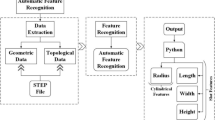Abstract
Feature recognition is the key to the computer-aided design (CAD) and computer-aided manufacturing (CAM) integration to build a computer-integrated manufacturing system. There are two approaches to CAD feature recognition: platform-dependent and platform-independent. In the platform-independent approach, the part’s geometrical data are extracted from a neutral file such as DXF, IGES, or STEP. In contrast, the platform-dependent approach extracts the information of the design features directly from a design-by-feature solid model through the object-oriented model of a part. This paper explains a platform-dependent approach which is implemented to translate design features into manufacturing information. This approach begins with simplification using the suppression of fillets, and clustering non-intersecting design features is done. Then, the rule-based method is employed in order to recognize machining features. Finally, the needed manufacturing information such as tool accessing direction, dimensions, material removal regions, and geometrical and topological data is recognized. The application of the proposed system would be exhibited in generating machine path code for rapid prototyping and CNC machines and providing a database for computer-aided process planning. The proposed system was implemented on Autodesk Inventor and successfully tested for many complex 3D models.
Similar content being viewed by others
References
Jain PK (1999) Extraction of compound volumetric features from a three-dimensional wire frame model. Proc Inst Mech Eng B J Eng Manuf 213:597–613
Wong TN, Lam SM (2000) Automatic recognition of machining features from computer aided design part models. Proc Inst Mech Eng B J Eng Manuf 214:515–20
Dimov SS, Brousseau EB, Setchi RM (2005) Automatic formation of rules for feature recognition in solid models. CUIMRC Working Paper Series 034
Joshi S, Chang TC (1988) Graph-based heuristics for recognition of machined features from a 3D solid model. Comput Aided Des 20:58–66. doi:10.1016/0010-4485(88)90050-4
Zhang C, Chan KW, Chen YH (1998) A hybrid method for recognizing feature interactions. Integr Manuf Syst 9(2):120–128. doi:10.1108/09576069810202078
Ibrahim RN, McCormack AD (2005) Robustness and generality issues of feature recognition for CNC machining. Int J Adv Manuf Technol 25:705–713. doi:10.1007/s00170-003-1929-y
Gao S, Shah JJ (1998) Automatic recognition of interacting machining features based on minimal condition subgraph. Comput Aided Des 30(9):727–739. doi:10.1016/S0010-4485(98)00033-5
Rahmani K, Arezoo B (2007) A hybrid hint-based and graph-based framework for recognition of interacting milling features. Comput Ind 58:304–312. doi:10.1016/j.compind.2006.07.001
Ozturk N, Ozturk F (2004) Hybrid neural network and genetic algorithm based machining feature recognition. J Intell Manuf 15:278–298. doi:10.1023/B:JIMS.0000026567.63397.d5
Chen YH, Lee HM (1998) A neural network system for two-dimensional feature recognition. Int J Comput Integr Manuf 11(2):111–117. doi:10.1080/095119298130859
Ozturk N, Ozturk F (2001) Neural networks based non-standard feature recognition to integrate CAD and CAM. J Comput Ind 45(2):289–299
Han J (1996) 3D geometric reasoning algorithms for feature recognition. Ph.D. Thesis, University of Southern California
Regli WC, Gupta SK, Nau DS (1997) Towards multiprocessor feature recognition. Comput Aided Des 29(1):37–51. doi:10.1016/S0010-4485(96)00047-4
Lee JY, Kim K (1998) A feature-based approach to extracting machining features. Comput Aided Des 30(13):1019–1035. doi:10.1016/S0010-4485(98)00055-4
Woo Y, Sakurai H (2002) Recognition of maximal features by volume decomposition. Comput Aided Des 34:195–207
Huang Z, Xie B, Ma L, Wei X (2006) Feature conversion based on decomposition and combination of swept volumes. Comput Aided Des 38:857–873. doi:10.1016/j.cad.2006.04.011
Li WD, Ong SK, Nee AY (2002) Recognizing manufacturing features from a design-by-feature model. Comput Aided Des 34:849–868. doi:10.1016/S0010-4485(01)00156-7
Sadaiah M, Yadav DR, Mohanram PV, Radhakrishnan PA (2002) Generative computer-aided process planning system for prismatic components. Int J Adv Manuf Technol 20:709–719. doi:10.1007/s001700200228
Zhu H, Menq CH (2002) B-Rep model simplification by automatic fillet/round suppressing for efficient automatic feature recognition. Comput Aided Des 34:109–123. doi:10.1016/S0010-4485(01)00056-2
Hayasi M, Asiabanpour B (2008) Machine path generation using direct slicing from design-by-feature solid model for rapid prototyping. Solid Freeform Fabrication (SFF) Symposium, Austin, TX
Author information
Authors and Affiliations
Corresponding author
Rights and permissions
About this article
Cite this article
Hayasi, M.T., Asiabanpour, B. Extraction of manufacturing information from design-by-feature solid model through feature recognition. Int J Adv Manuf Technol 44, 1191–1203 (2009). https://doi.org/10.1007/s00170-008-1922-6
Received:
Accepted:
Published:
Issue Date:
DOI: https://doi.org/10.1007/s00170-008-1922-6




